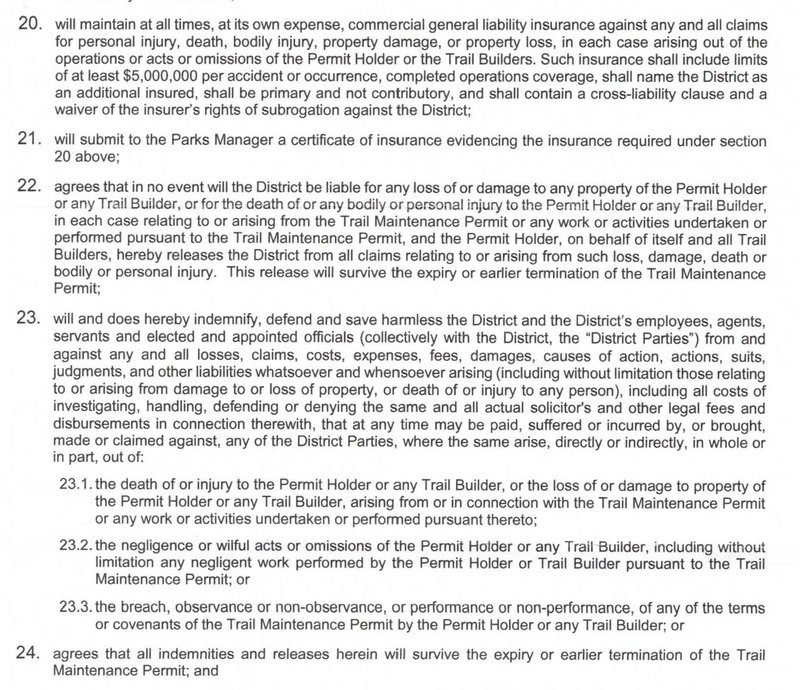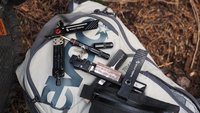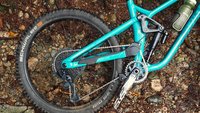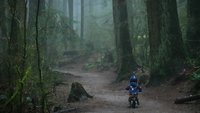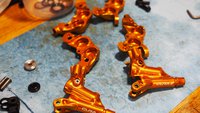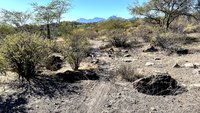100%. I am a forester and this always comes to mind for me as well. A good example is what is happening on Burke Mountain, where crown land was sold to a developer that is almost completely deforesting the area to build mcmansions, which includes removing bike trails that have been there for years.
Coiler profile
Coiler
Joined April 4, 2022
Activity
Recent
Contributor (0)
Photos (0)
Buy and Sell Ads (0)
Comments (4)
Forum Posts (9)
Recent activity
-
Posted in Winter Down Country Tires
2 months agoPosted by: heathen
Posted by: Coiler
I have …
-
Posted in Winter Down Country Tires
2 months, 1 week agoI have been riding a blur TR for …
-
Posted in "Buckin Hell“ trail run race. Down empress bypass?
1 year, 5 months agoPosted by: thaaad
Speaking of tape, am I …
-
Posted in NSMBA Strategic Plan
1 year, 6 months agoPosted by: syncro
I feel that moving forward …
-
Posted in Revitalizing the CBC trail on Seymour
1 year, 7 months agoWent up there yesterday to check it out. …
Buy and Sell Ads
Comments
The car analogy is really interesting, but I’ll admit it breaks down a bit and can be used to push hyperbolic arguments. But there are some interesting parallels and scary conclusions. For example, due to the safety concerns of cars and pedestrians mixing, we created a set of rigid rules that essentially excluded pedestrians from roads, and they became the domain of the car. Now obviously we analog (way better term) riders aren’t going to lose our trail access. But I do think there it's conceivable that more explicit rules will start being needed to deal with eMTBs, which could seriously affect the way we all ride.
By way of local example: on the north shore we have very clear up and down routes. Alot of these are established by the limitations of analog bikes with the existing trails. No one is biking up expresso, because that would just be ridiculous on an analog bike. But with eMTBs, not only is that possible, its probably the most efficient climbing route to get to that section of Fromme. So now trail managers might need to start integrating the capabilities of eMTB into their signage and trail strategies.
Maybe that’s a bad example, because anyone with any common sense or pre-planning isn’t going to do that. But there was a story kicking around the nsmb forums of someone on an eMTB just ripping around the woods on lower Fromme, blazing across the mountain off-trail. That would be absurd on an analog bike, but with that extra couple hundred watts on an eMTB you can make it happen.
That’s the worry I have with eMTBs: they open up access to a huge area, with potential for even more loam lines forming all over the place. The amount of unsanctioned trails on Seymour and Fromme is pretty crazy right now, and they are becoming ridiculously visible and ridden in. We are lucky now that these are limited by where we can reasonably access them, so I think in big picture terms the land managers turn a blind eye because the impact remains reasonably limited. But that might change when we have these trails going further and further, maybe even deep into the watershed.
Anyway, that’s my alarmist take on eMTBs, at least here on the shore where I ride.
I personally do not like eMTB and I do agree that they tend to dilute the MTB experience that I am looking for. However, I think creating this binary of acoustic vs motorized is simplistic and counter productive. There is way more nuance to it. For example, adaptive mtbs aren't technically bicycles, but I think we all agree they have more in common with mtb's than they do with soapboxes.
It's more accurate to approach it as a spectrum. At one end we have a fixed gear, rigid, brakeless bike. The simplest form of bicycle. On the other, we have a motorbike. In between we have all these other types. And in that sense, it's obvious (to me at least) that eMTBs and acoustic MTBs are pretty darn close together on that spectrum. That's why banning eMTBs or getting all worked up about them is a really unsatisfactory approach.
I think the real problem we have here is we (the riding community) is really struggling to adapt with the growth of this segment of the sport. A good analogy is the invention of the car. Previously, streets were shared places dominated by pedestrians. Cars came, and their ubiquity and convenience transformed these shared places into car dominated spaces. People actually hated cars when they were invented, because they were tools of the rich that ruined and made the streets unsafe for the poors, often because there weren't clear guidelines and laws. But cars were so convenient and attractive, soon enough everyone had them, and we lost what we had without even realizing it.
The worry we have with eMTB is that we are really failing (in my opinion) to reconcile these new tools with the pre-existing networks and standards of behaviour we are used to. And I think all this "eMTB's are motorbike, not bikes" is just burying our head in the sand and not acknowledging the real issue: "eMTBs are here, getting more and more popular, and we aren't dealing with this new type of trail user."
This is a great prairie bike! Although the riding in Calgary and Edmonton is very tame (see gravel bike joke below), everyone I know that rides in the prairies heads to Golden/Revy/Valemount all the time to ride burly trails. This would be a perfect bike, obviously overbiked for the prairies but not ridiculously so, and totally capable for trips to the mountains.
Forum Posts
Posted by: heathen
Posted by: Coiler
I have been riding a blur TR for the past 6 months. I rode the stock Rekon Races for the first little bit, they were surprisingly fun and predictable. Until I did a wet ride in whistler and it was terrifying and not fun at all. I switched to the specialized ground control T5 (the firmer compound). I have been super impressed with them. Super predictable and very good grip, even in wet conditions. Great rolling resistance so fun for faster XC rides.
This was also my experience. Fun in the dry as a front. Terrifying in the wet.
Jinxed myself, sliced a sidewall today on my rear. It wasn’t much of a sharp rock either, was on neds. Of course I didn’t have a boot, which would have been an easy fix, had to slap a tube in and wear my insert like a sash!
I have been riding a blur TR for the past 6 months. I rode the stock Rekon Races for the first little bit, they were surprisingly fun and predictable. Until I did a wet ride in whistler and it was terrifying and not fun at all. I switched to the specialized ground control T5 (the firmer compound). I have been super impressed with them. Super predictable and very good grip, even in wet conditions. Great rolling resistance so fun for faster XC rides.
Posted by: thaaad
Speaking of tape, am I the only one who is infuriated when I see plastic tagging from old races? How is this not considered littering? As much as I love races the organizers should 100% be liable for removing ALL of the tape from ALL of the races they put on.
It makes me so pissed off when I see race tape from old races that is very obviously weeks old. This isn't to say that it's MTB races for sure but I can't believe people just abandon their litter / tags in the woods.
Literally the 3rd google result...
100% agreed. I'm a forester and try to always make sure someone gets the tape down at the end of a project. I did once work on a project in Alberta where we used that biodegradable tape, big series of cutblocks we spent a few days laying out. Next year we had to come back to check on it before harvesting....deer had eaten it all!!! You could see the teeth scratches on the trees. Had to laugh, but having to redo all that work almost made us cry.
Posted by: syncro
I feel that moving forward the single most important factor is to consider the cohesiveness of the entire trail network before adding new trails or making significant changes. We have to consider not only the the type of trails that get put in but how they interact with each other and potential for any future new trails.
As an example, I have always found that Expresso a weird case. Its (argubably) the most popular trail, and the NSMBA puts lots of work into it. The logical way to ride it is to go up from the Fromme Parking lot along the road, then drop in. But it spits you out on Baden Powell, and the ride back to the parking lot is very different than Expresso. I think for many newer or intermediate riders, it ultimately ends up being a pretty poor experience after the flow fest on Expresso. Not sure what the solution is; I personally love that section of Baden Powell and would be sad to see it get buffed out. But I do think its illustrative of a incohesive portion of the trail network.
Just curious what other examples you (or anyone else) might have?
Went up there yesterday to check it out. It's actually in surprisingly good shape considering how bad I heard it was. I went in fully expecting to walk the entire trail, but there were only three particularly bad sections where it was would be damaging to ride. Overall I thought the trail work was pretty good; I hated the old CBC and I could see myself riding this occasionally!
Posted by: Kenny
Posted by: Coiler
Posted by: Silk
Thanks all!
I forgot to mention if you could put in a good word inside the survey for the Independent Builders on Pipeline / Fromme that would be of great help.
As of April 29th the builders of Pipeline can no longer do any maintenance until further notice. Due to recent unsanctioned / unapproved building on Seymour
the DNV wants us to sign a new builders agreement that we will not sign due to the wording and requirements of commercial general liability insurance for each builder
of Pipeline.
See sections 20 - 24
Section 23 is especially alarming and we the builders will not take on all liability of a fully sanctioned trail with
building plans approved by the DNV.
Thanks again!
That's so nuts! 5 million CGL is friggin expensive, and having to name the DNV is also wild. I'd love to hear an insurance broker take on this; CGL for a bike trail builder must be incredibly hard to find.
Yeah, and it's not really the broker though, it's the underwriter/risk assessor people and this is all calculated based on the historical claims for any given industry. These guys are box checkers and I doubt there's a box for "chainsaw in the woods building stuff".
Unless the DNV actually worked with an insurance company to help organize an insurance policy specifically for trail builders, this will be next to impossible to obtain, because it literally doesn't exist.
You're absolutely right. I am a forestry consultant, recently worked on a really unique project and the client required 5 mill CGL. Although the context is totally different, in my experience getting an underwriter to insure unique work is very difficult, and the few that are willing to do it charge crazy high insurance premiums.
Posted by: Silk
Thanks all!
I forgot to mention if you could put in a good word inside the survey for the Independent Builders on Pipeline / Fromme that would be of great help.
As of April 29th the builders of Pipeline can no longer do any maintenance until further notice. Due to recent unsanctioned / unapproved building on Seymour
the DNV wants us to sign a new builders agreement that we will not sign due to the wording and requirements of commercial general liability insurance for each builder
of Pipeline.
See sections 20 - 24
Section 23 is especially alarming and we the builders will not take on all liability of a fully sanctioned trail with
building plans approved by the DNV.
Thanks again!
That's so nuts! 5 million CGL is friggin expensive, and having to name the DNV is also wild. I'd love to hear an insurance broker take on this; CGL for a bike trail builder must be incredibly hard to find.
Both articles are bad. I agree CBC totally misrepresents CJ's article by basically attacking her for what she didn't say. But I think CBC is really picking at the edge of the carpet here, and I don't think CJ's article was ignorant or problematic at all.
Her article seems to me to say: there is no elite clique of women's riders that are selecting each other for every event, but rather the best marketed riders are all invited to the events, and they just happen to be the same group as that (alleged) clique of women's riders. And if you want to be in the gang, here is how you can be better and get invited. I think it is kind of a gross, subtly narcissistic article, but its not wrong. Maybe I am being a bit over sensitive, but she's really saying the quiet part loud: the riders that get invited to big events are the ones that make corporations the most money. Be a better product for a corporation, and you'll go far.
Long time forum lurker, but wanted to comment on this as its right in my wheelhouse (I am a Forester in the Sea to Sky area). Also, I do not work in a timber harvesting or tree planting capacity, so I like to think I can be unbiased.
Big picture, herbicides really aren't that big of a deal in a forest setting (in contrast with the very heavy annual use they get in agriculture). Glyphosphate is one of the most studied chemicals ever, and while there are some studies linking it to increased cancer in humans, those are largely in people who interact with this chemical on a daily basis (landscapers, farmers, etc). This is very different from the often aerial helicopter spraying in a forestry application, where it occurs a few times early on in a new plantation. Glyphosphate isn't great for animals, but as long as the spraying guidelines are followed there is minimal risk.
HOWEVER: glyphosphate kills plants. That's its job. Specifically non-conifer, deciduous plants. The aim is to give the conifer plantings an advantage early on, so they can outgrow the competing deciduous plants. Naturally deciduous plants regrow much faster, and reduce conifer growth rates through competition. Since the goal of planting is to get a conifer forest established ASAP, herbicides are often used. A fact is that this dramatically reduces biodiversity in the forest for the first few years. However, once the conifers are established, typically the herbicide stops getting used, and the deciduous understory really bounces back. An important note that herbicide is not used that frequently, but in specific sites where the deciduous competition will be an issue for the conifer plantings. This is because it is very expensive to apply.
Focused on this BCTS Pest Management Plan (PMP). There is a lot of misunderstanding on this BCTS plan. It is a very large scale and broad landscaping plan. It only includes herbicide use as an option within the area it applies to. It does not identify specific areas for herbicide application, the total area for herbicide use, and the amount that this will be used. Ultimately it might not even be used at all, but its kept as an option in this plan as an optional tool in the toolbox. The actual use of herbicide is on a much, much smaller scale than this plan implies (think dozens of hectares at the site scale, vs 10,000s of hectares at the PMP level). Herbicide use is also highly dependent on site characteristics like ecology, access, and also economics, because herbicide is so expensive.
The biggest harmful effect of glyphosphate is it kills deciduous understory plants and promotes conifer stands, resulting in a reduction in biodiversity. The biodiversity typically bounces back a few years after application. This promotion of natural conifers is a key foundation of forestry in BC: this is why we tree plant, why people brush out the deciduous in plantations, why there are goats trained to eat deciduous (for real), and this is why we use herbicide. I think the real question isn't whether we should use glyphosphate or not, its whether we should be managing these forests so intensely for conifer growth.
Anyway, feel free to ask me anything about this our forestry in general.
Forum jump:
